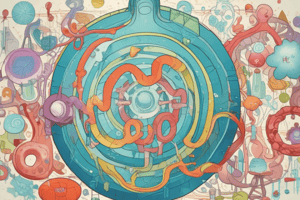Podcast
Questions and Answers
What is the precursor for the synthesis of catecholamines?
What is the precursor for the synthesis of catecholamines?
Tyrosine
Which enzyme catalyzes the conversion of tyrosine to 3,4-dihydroxyphenylalanine (DOPA)?
Which enzyme catalyzes the conversion of tyrosine to 3,4-dihydroxyphenylalanine (DOPA)?
- Tyrosine hydroxylase (correct)
- Phenylethanolamine N-methytransferase
- Aromatic amino acid decarboxylase
- Dopamine β-hydroxylase
Histamine is formed by decarboxylation of histidine.
Histamine is formed by decarboxylation of histidine.
True (A)
____________ is the active part of Glutathione (GSH) and is attached via the -SH group of cysteine.
____________ is the active part of Glutathione (GSH) and is attached via the -SH group of cysteine.
What is the hormone mostly synthesized by the pineal gland?
What is the hormone mostly synthesized by the pineal gland?
Flashcards are hidden until you start studying
Study Notes
Conversion of Amino Acids to Specialized Products
- Certain proteins contain amino acids that have been post-translationally modified to perform specific functions.
- Hydroxylation of lysine to 5-hydroxylysine stabilizes maturing collagen fibers.
Importance of Amino Acids
- Amino acids serve as precursors of diverse biologic materials.
- Examples of biological molecules derived from amino acids include:
- Creatine and creatinine
- Catecholamines
- Serotonin and melatonin
- Histamine
- Glutathione (GSH)
- Purine and pyrimidine rings
Creatine and Creatinine
- Creatine is stored in the muscle in the form of creatine phosphate, which acts as an energy store.
- Creatinine is formed in muscle from creatine phosphate by irreversible, non-enzymatic dehydration, and loss of phosphate (used for muscle contraction).
- The amount of creatinine produced is constant from day to day and depends on muscle mass.
- Creatinine is excreted in urine.
Catecholamines
- The name catechol refers to the dihydroxylated phenyl ring.
- The amine derivatives of catechol are called catecholamines.
- Tyrosine is the precursor for the synthesis of catecholamines, namely:
- Dopamine
- Norepinephrine (noradrenaline)
- Epinephrine (adrenaline)
- Conversion of tyrosine to catecholamines occurs in adrenal medulla and central nervous system.
- Enzymes involved in catecholamine synthesis:
- Tyrosine hydroxylase
- Aromatic amino acid decarboxylase
- Dopamine β-hydroxylase
- Phenylethanolamine N-methyltransferase
- Catecholamines regulate carbohydrate and lipid metabolisms, stimulate the degradation of triacylglycerol and glycogen, and cause an increase in blood pressure.
- Dopamine and norepinephrine serve as neurotransmitters in the brain and autonomous nervous system.
Serotonin and Melatonin
- Serotonin (5-hydroxytryptamine, 5HT) is a neurotransmitter synthesized from tryptophan.
- Enzymes involved in serotonin synthesis:
- Tryptophan hydroxylase
- Aromatic amino acid decarboxylase
- Melatonin is a hormone, mostly synthesized by the pineal gland.
- Serotonin is acted upon by serotonin N-acetylase to give N-acetylserotonin, which undergoes O-methylation to produce melatonin.
- Synthesis and secretion of melatonin from pineal gland is controlled by light.
Histamine
- Histamine is a biogenic amine that functions in allergic reactions and gastric acid secretion.
- Histamine is formed by decarboxylation of histidine, catalyzed by pyridoxal phosphate-dependent enzyme histidine decarboxylase.
- Histamine is present in all tissues.
Glutathione (GSH)
- Glutathione is γ-Glutamyl cysteinyl glycine.
- The active part is the -SH group of cysteine (sulfhydryl group).
- Biosynthetic reactions of GSH are catalyzed by γ-glutamyl cysteine synthetase and GSH synthetase.
Studying That Suits You
Use AI to generate personalized quizzes and flashcards to suit your learning preferences.





